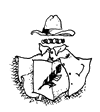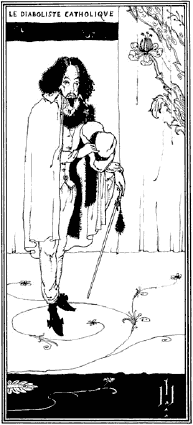 |
 |

Enoch’s Castle
For several years before his transformation into a veritable shade, Enoch Soames had flitted through the poetic, painterly and occultist circles of fin-de-siècle Paris, an English spectre—albeit a rather dim spectre—stalking the margins of the Banquet Years. Certain facts about this period have long been agreed by Soames scholars: his meetings with Rothenstein and Harland at the Café Groche and elsewhere; his touching friendship with the dying Villiers de l’Isle Adam (one of the few contemporaries to whom he would ever concede any artistic merit); his bitter quarrel with that “épicier malgré lui” Verlaine, and so on. Until the late months of 1896, however, long stretches of Soames’s crucial Parisian years were a matter for speculation, educated guess and heated debate.
But blazing light has now been cast into this tantalisingly crepuscular zone by a chance discovery which may, in the next few years, bring about nothing less than a revolution in Soames studies. Last August,Note 1 a M. Charles Montel, one of the under-librarians involved in the epic task of relocating stock from the former Bibliothèque Nationale to its imposing new home on the banks of the Seine, happened upon a set of autograph manuscripts bearing dates between 1864 and 1916. Though the hand was hard to decipher, and the contents appeared at first sight to consist of little more than the disjointed, indeed paranoid, ravings of some justly failed writer, M. Montel soon recognised that these texts must be the intimate journal of Hugo Vernier (1836–1916/17?), author of a single, uniquely influential masterpiece: Le Voyage d’Hiver, published by Hervé Frères of Valenciennes in 1864—the date, that is, at which the MS. begins.Note 2
M. Montel is still hard at work on deciphering Vernier’s crabbed scribblings, and many of his readings will remain conjectural for some time. For all this, his preliminary explorations of the manuscript have already helped settle a number of fiercely contested disputes concerning some five decades of French cultural life, and though M. Montel frankly concedes that he has little personal interest in “ce petit poète Prestonian,”Note 3 his generosity in sharing the fruits of his continuing research with British colleagues has been heartening. A new century will have dawned before his labours come to an end; for now, we can be more than content—indeed, we must be astonished—with the handful of revelations M. Montel has granted us so liberally.
Put simply, our interim conclusions are twofold. Despite Soames’s proud boast that “I owe nothing to France,” it is now more plain than ever that he was not only influenced by his Parisian contemporaries, but left his own mark on French letters; and des- pite widespread claims that Soames’s early Diabolist period was little more than an affectation,Note 4 it is now undeniable that he grew ever more deeply involved in many forms of occult science, from Rosicrucianism to Black Magic, throughout his stay on the other side of the Channel.
To consider the latter point first: it now appears beyond reasonable dispute that the “smooth-shaven, melancholy man” seen at the Black Mass attended by the hero of Là-Bas, Huysmans’s roman à clef about contemporary Satanism (Chapter XIX), can have been none other than our poet. This possible attribution has long been rejected on the grounds that Soames, far from being smooth-shaven, habitually cultivated a beard, albeit a scanty one. The Vernier document, however, shows that Huysmans—who appears to have encountered Soames several times at one of the celebrated Mardis at 87 Rue de Rome—was fond of mocking Soames’s inability to achieve a facial growth comparable to Mallarmé’s, and would pretend to admire Soames’s skill with cut-throat razor and soap in terms as loud as they were humiliating.
Soames bore the verbal mockery with relative good grace, but when the joke was immortalised in print in 1891, with the publication in serial form of Là-Bas in the Echo de Paris, he took violent exception, ceased to attend the Mardis and would cut Huysmans when- ever they encountered each other in the street. Before this time, their relations had been warm. A precocious reading of Huysmans’s “breviary of the Decadence” À Rebours (1884), had indeed been one of the lures which first brought Soames to Paris, and in 1889, for example, Huysmans and Soames had joined Mallarmé and Dierx as witnesses to the marriage in extremis of Villiers de l’Isle Adam; Soames was a last-minute replacement for Coppée, who declined to attend.Note 5 Soames also joined Huysmans and Mallarmé in editing Axel, the work which, thanks to Edmund Wilson’s Axel’s Castle, is now Villiers’s best-known production. It was published some five months after the writer’s death, in January 1890. How sublimely fitting that Soames—so neglected a figure in his day, so haunting for us today—should have been an unacknowledged presence in the work which is now seen as the paradigm of Symbolisme!
Huysmans’s reaction to the “smooth-shaven” episode remains unknown, What is definite, however, is his dismay at the extent to which Soames had become involved in Diabolism. Piecing together hints in the Vernier MSS., we can establish that Soames must have been recruited to the Black Mass by Charles Buet, the Catholic historian who provided Huysmans with the original of his villain M. Chantelouve.Note 6 Vernier, who among other epithets refers to Soames as a “lanky, dishevelled demonologist,”Note 7 also shows that the English poet came to the Black Arts by way of a more benign occultist, the Sår Péladan. One of the final clear glimpses of the Parisian Soames comes in Vernier’s account of Péladan’s first Salon des Rose & Croix at the Durand-Ruel gallery in 1892. No longer do historians have to speculate as to the identity of the “abusive Englishman” whose insults and howls of rage could be heard above the sound of Erik Satie’s trumpet fanfare, and who had to be forcibly ejected into the night.Note 8
A great deal of work remains to be done on Soames’s career as Diabolist and we must assume that not all of its findings will be agreeable. For the moment, therefore, let us conclude with a note more appropriate to a volume of celebration, and recall some of the happier episodes in our poet’s brief and tragic life. For thanks to Vernier—yet another writer who does not, alas, seem greatly to have liked Soames—we can warm ourselves with the knowledge that Paris proved to be the home for the warmest, perhaps the only profound friendships Soames was ever to know.
It was at the café Chat Noir, now best remembered as the favoured watering hole of the Neuropath poet Maurice Rollinat,Note 10 that Soames first came face to face with Adoré Floupette, scandalous author of Les Déliquescences: Poèmes décadents (1885) and the con troversial critic Jacques Plowert, whose Petit Glossaire pour servir à l’intelligence des poètes décadents et symbolistes created such a stir in Symbolist circles on its first publication in 1888. It was Floupette who taught Soames the allure of the sorcière glauque in long drinking sessions with the Hydropath circle, and, more important to our writer’s sometimes faltering sense of his mission, welcomed him as a brother poet. It was Plowert who wrote the earliest Francophone appreciation of Soames’s verse, in his column for Le Symboliste.Note 11
We can confidently expect that further decipherings of the Vernier MSS. will yield further and perhaps still more remarkable discoveries for students of fin-de-siècle art, literature and hermeticism. Few, though, will be quite as extraordinary as one of the latest of M. Montel’s gleanings. Three years before their first absinthe-soaked encounter, Soames and Floupette had begun an intense and impassioned correspondence; each man somehow saw in the other a semblable, a frère. Unknown to the fashionable world, this correspondence grew into a collaboration, for we now know that the “Marius Tapor” who wrote the introduction to Floupette’s Déliquescences purporting to be a pharmacist friend of Floupette’s was in fact none other than... Enoch Soames!
Unkind as the sentiment may be, it is hard not to relish the dismay with which Soames’s detractors—who have sought so strenuously to deny the poet’s manifest qualities of wit, vivacity and ingenuity—will greet the revelation that Soames was the author of one of the late nineteenth century’s most gleeful literary hoaxes.
- i.e. August 1996—Ed.
- For more on Vernier, see the article by G. Perec in Hachette Informations 18, March–April 1980; reprinted in Magazine Littéraire 193, March 1983.
- Charles Montel; private communication to the author, 3 January 1997.
- For a survey of sceptics, see my article “Better the Devil He Didn’t Know: Was Soames a True Diabolist?” in The Journal of Victorian Satanism, vol.6. no.4, November 1992. Some of my conclusions will, of course, have to be modified in the light of the Vernier MSS.
- For an account of these mournful nuptials, published too early for the identity of the “person replacing Coppée,” to have been established, see Gordon Millan, Mallarmé: A Throw of the Dice (London, Secker & Warburg, 1994), p.270.
- See Robert Irwin, “Introduction” to the Dedalus European Classics edition of Là-Bas: London, Dedalus, 1986.
- M. Montel’s translation. Oddly, the phrase anticipates Aleister Crowley’s scornful description of W. B. Yeats.
- On Sår Péladan and related figures, see Philippe Jullian, Dreamers of Decadence (London, Phaidon, 1974 second edition) pp.75-85.
- See Matthew Sturgiss for Soames’s own poeticised account of what is almost certainly this occasion—Ed.
- For a fascinating, and entirely convincing, account of the origins of Soames’s poem “Nocturne” in one of Rollinat’s Satanic verses, see Patrick McGuinness, Journal of Victorian Satanism, vol.8, no.1, Feb–Mar 1994. See also the Cahiers des Amis de Maurice Rollinat, passim.
- See Patrick McGuinness, New Bearings in Deliquescent Poetry: Floupette, Soames and their Exegetes, in Floupettiana, forthcoming, Autumn/Winter 1999. I am grateful to Dr. McGuinness for the many enlightening discussions we have enjoyed on these and related subjects, and particularly those at the conference on Deliquescence he organised at Jesus College, Oxford, in January 1997.

